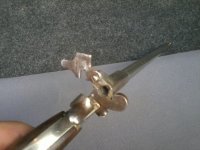Wild Bill Bucks
New member
http://thefiringline.com/forums/att...ent.php?attachmentid=71164&stc=1&d=1307991691
Caliber of this pistol is .22 short with a smooth bore barrel, with an overall length of apprx. 9".
Do any of you recognize the manufacturer and can tell me what this is?
Caliber of this pistol is .22 short with a smooth bore barrel, with an overall length of apprx. 9".
Do any of you recognize the manufacturer and can tell me what this is?



